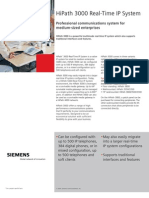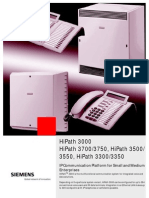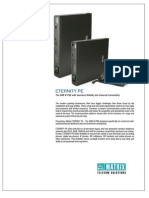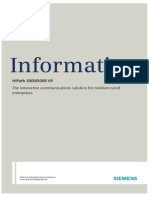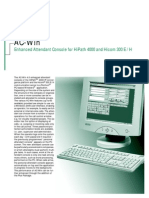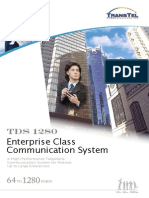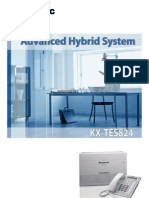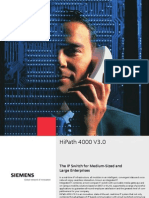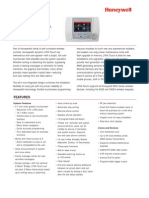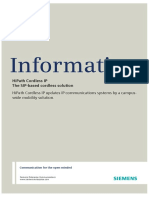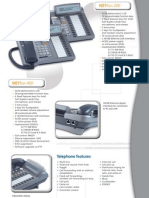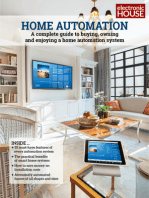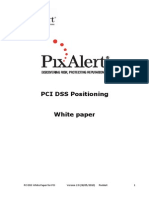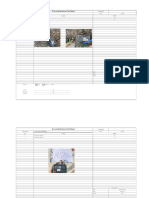Hipath 3000 V6.0: High-Performance Modular Communications Plat-Form For Small and Medium-Sized Enterprises
Hipath 3000 V6.0: High-Performance Modular Communications Plat-Form For Small and Medium-Sized Enterprises
Uploaded by
bmurilloCopyright:
Available Formats
Hipath 3000 V6.0: High-Performance Modular Communications Plat-Form For Small and Medium-Sized Enterprises
Hipath 3000 V6.0: High-Performance Modular Communications Plat-Form For Small and Medium-Sized Enterprises
Uploaded by
bmurilloOriginal Description:
Original Title
Copyright
Available Formats
Share this document
Did you find this document useful?
Is this content inappropriate?
Copyright:
Available Formats
Hipath 3000 V6.0: High-Performance Modular Communications Plat-Form For Small and Medium-Sized Enterprises
Hipath 3000 V6.0: High-Performance Modular Communications Plat-Form For Small and Medium-Sized Enterprises
Uploaded by
bmurilloCopyright:
Available Formats
HiPath 3000 V6.
0
High-Performance Modular Communications Plat-
form for Small and Medium-Sized Enterprises
The HiPath 3000 IP Convergence System of-
fers medium-sized enterprises with up to
1,000 users reliable voice communication
with high-quality terminal devices that are
very simple to use.
If HiPath 3000 is used as a standalone sys-
tem, it can be operated with up to 500
workpoints.
Up to 32 HiPath 3000 systems can be net-
worked and managed as a single system by
using a HiPath 5000 Realtime Services Man-
ager (refer to the HiPath 5000 Realtime IP
System datasheet).
HiPath 3000 comes in three variants for dif-
ferent-sized locations:
HiPath 33xx, HiPath 35x0 and HiPath 3800.
HiPath 3800 is a high-end hardware plat-
form with improved performance. An ex-
tensive and common set of features is
provided across all systems through the
HiPath ComScendo featureset.
System Family
HiPath 3000 is available for
various installation
scenarios
Floor mounted: HiPath 3800
Wall mounted: HiPath 3550/3350
19" rack mounted: HiPath 3800/3500/
3300
HiPath ComScendo
Features
Caller list. Unanswered internal and exter-
nal calls are listed by system telephones
with display if external numbers include a
directory number (ISDN) (caller identifica-
tion). Internal calls show the name of the
caller. The calls are listed with date and
time, and the number of attempted calls is-
recorded. A callback can also be initiated via
this list.
Do Not Disturb/On-hook. Users can reject
incoming calls. When Do Not Disturb is acti-
vated, callers hear the busy tone. Autho-
rized users (e.g. the operator) can override
this function. Acoustic signalling can be de-
activated in system telephones so that calls
only appear on the display (not available for
optiset E/optiPoint 500 entry).
Call pickup. Users can pick up calls within a
call pickup group or selectively for individu-
al colleagues in a node or outside nodes on
their own telephones.
Intrude. Authorized stations can intrude on
other users calls in progress.
Call Barring.
Various classes of service can be allocated
to each station user.
Paging (Internal Announcement) to sys-
tem telephones or over external loudspeak-
ers.
Call Details for each terminal or each trunk
can be displayed on a system phone, e.g.
call duration. (Call Accounting requires the
purchase of external equipment.)
Group call for a total of 800/150/20 (model
dependent) groups with max. 20 users per
group. Individual stations can leave the
group temporarily.
Trunk keys (MULAP)
The following flexible setups are possible
with trunk keys:
teams,
executive/secretary functions,
feature handset (Gigaset) in parallel with
a system telephone on a single call num-
ber (only in conjunction with HiPath
Cordless).
LDAP interface for access to enterprise-in-
ternal telephone directories with direct dial
option via the telephone.
Internal telephone directory. All exten-
sions are stored with their associated
names in the systems internal telephone di-
rectory. They can be searched and dialed di-
rectly via the display on system telephones.
Speed dial for individual station/system.
All systems enable up to 10 destinations to
be stored individually on each telephone
and up to 1,000 centrally in the system. Sys-
tem numbers are accessible via the internal
telephone directory.
Toggling between two existing connec-
tions.
Text messages. Users can send predefined
(e. g. "visitor waiting") or individually com-
posed short messages (only optiPoint 600
office with USB keyboard) to other users
with display phones.
Internal text messages can also be sent to
Gigasets cordless handsets.
Advisory messages can be left on your
telephone (e.g. back at:....).
Project code. Telephone costs can be as-
signed to a specific procedure or project by
entering the project code (max. 11 digits).
This can also be done while a call is in
progress.
Call number suppression. Callers with
ISDN connections can prevent their call
number being sent to the terminal of the
station called.
Call ring tones can be differentiated for in-
ternal calls, external calls, recalls and call-
back.
Multi-telephone ringing. Call ringing si-
multaneously at several telephones.
Switches (actuators/sensors) (optional)
It is possible to use a control relay module to
connect up to four free relays, which can be
selected via codes (optional).
Door interface.
For entrance telephone and door opener
functions. Calls from an entrance telephone
can be transferred to external destinations
via external call forwarding.
Automatic redial (expanded) for the last
three external call numbers dialled.
Standard Functions
Intercept position e.g. route to the
operator
Camp-on/call waiting tone
Display languages (can be specified
individually)
Conference (internal/external)
Line seizure (automatic)
Music on hold
External music source (optional)
Night service/day service
Park
Consultation
Call back for busy line (when free) and
unanswered call (when next used)
Call forwarding/Divert - no answer, no
reply
Hunt group (linear/cyclic)
Pick up Groups
Group calls
Telephone block
(individual code block)
Telephone book, central
Transferring a call (internal/external)
Caller list
Attendant Consoles
optiPoint Attendant
An optiPoint system telephone can be used
as an attendant console. This can be orga-
nized as an information, intercept, or night
service station.
The attendant console can be accessed in-
ternally via a second directory number.
If the number of users on hold reaches a
preset level, calls will be forwarded to a
specified destination. This will also take
place when the length of time a call is
queued exceeds a specified limit.
optiClient Attendant
This software package simulates an en-
hanced attendant console on a PCs screen.
All features can be activated and executed
via the PC keyboard and mouse.
The PC Attendant can be connected via
V.24, USB or via IP.
optiPoint BLF
The busy lamp field (BLF) is an additional
module principally for optiPoint Attendant.
BLF has over 90 freely programmable func-
tion keys which show a stations call status
via LED (free, busy, called).
Braille console
Optical displays are translated into Braille by
an add-on device connected to the PC. This
enables visually impaired employees to per-
form all call processing tasks. (Not available
in all countries.)
VoiceMail
Integrated VoiceMail
Entry VoiceMail (EVM) is a standard feature
of HiPath 33x0 and HiPath 35x0 in version
5.0 or higher. It supports 2 voice channels,
24 mailboxes (up to 4 of which can be Au-
toAttendant) and provides up to 2 hours of
recording time.
Executive /Secretary
Features
These features ensure rapid communica-
tion between executives and secretaries.
Camp-on at an executives phone by the
secretarys phone
Secretarial function transfer
Call transfer to the secretarys phone
DSS keys for executive/secretary
Conference corner telephone with paral-
lel call signaling to the executives phone
A private line can be set up for either the
executive or secretary
System Administration
System administration by the customer can
be carried out either using the telephone or
with HiPath 3000/5000 Manager C (addi-
tional information available in the HiPath
3000/5000 Manager C datasheet).
HiPath 3000/5000 Manager C is a customer
tool that runs under Microsoft Windows
and is connected to the system via a V.24,
S
0
or TCP/IP-based LAN interface.
The feature Assistant TC allows customers
to perform administration tasks on any sys-
tem telephone with a display. The optiPoint
500 telephone enhanced by the optional
"optiPoint application module" with inte-
grated keyboard is recommended for
this.
Hotdesking/Mobility
(IP Telephones)
These features enable several users to share
a workstation or to work as teleworkers
from home keeping their extension num-
bers. The telephone retrieves personal set-
tings when the user logs on. Extension
numbers, station features and key labeling*
remain unchanged (*in the case of opti-
Point 420 with self-labeling keys).
Data Protection/Data
Security
To protect the communication system and
customer data from unauthorized access,
the Service menu can only be entered by
means of individual user IDs.
User Solutions
HiPath Cordless
is an integrated solution based on the DECT
standard for full-coverage availability
throughout the company premises using
cordless phones. (Not available in all coun-
tries.)
HiPath Xpressions Compact
is an integrated voice messaging system for
deferred and location-independent storage,
retrieval, and distribution of voice messages
in users individual voice mailboxes. HiPath
Xpressions Compact provides an automatic
switching function.
HiPath Xpressions
is a complex unified messaging solution.
The communication central supports the
user in everyday voice, fax and e-mail, and
SMS information exchange. This enables
delivery of customized solutions for every
requirement from small entry-level options
to networked communication solutions.
HiPath ProCenter Compact
is the professional, cost-effective call center
software solution for up to 32 agents. This
allows optimum telephone-based customer
service transactions - from order placement
to complaints management.
HiPath ProCenter Office,
Agile, Entry, Standard and
Advanced
are additional products for comprehensive
contact center solutions. They allow opti-
mum deployment of resources for customer
interaction across all channels.
HiPath TAPI 120/170 and
HiPath CAP
The driver software was developed as a sup-
plement for connecting a PC to digital sys-
tem telephones on HiPath. CTI applications
conforming to TAPI are therefore integrat-
ed. Supported CTI applications are: HiPath
Simply Phone for Outlook and Lotus Notes,
HiPath ComAssistant and HiPath ComScen-
do on a Button Suite (XML Phone Services).
Teledata Office/HiPath
Accounting Management
Calculates the costs of all communication
services (telephone, fax, internet) and en-
ables analysis according to extension, trunk
or department. The communication data
can be transmitted directly via a LAN inter-
face to a central server for analysis. An ex-
tensive range of server-based applications
for call centers and unified messaging are
also available, as well as a high perfor-
mance LAN interface.
HiPath Fault Management
Supports maintenance staff in permanent
operational monitoring of the communica-
tion technology, following up even the
slightest indication of developing faults and
finding an immediate remedy.
HG 1500
HG 1500 is an integrated component of the
HiPath 3000 system family and extends
communication system functionality for
data traffic. The HG 1500 module is the
networking basis for max. 64 HiPath sys-
tems via the customers IP network.
VoIP: HG 1500 converts voice signals into IP
data packets, which can then transmitted
be via the data network.
Application interfaces: HG 1500 provides
the foundation for the web-based use of
third-party applications.
No external routers or additional servers are
required for LAN PCs because the router
functionality, firewall functions, and securi-
ty options are already integrated compo-
nents of HG 1500.
Encryption
Together with the integrated IP gateway
HG1500, HiPath 3000 offers a solution for
tap-proof communication with IP terminals
and between IP systems. The solution is
based on international standards. Uninter-
rupted protection is afforded from terminal
to terminal. The call data is encrypted be-
tween the Voice over IP terminals or gate-
ways using the Secure Realtime Transport
Protocol (SRTP, RFC 3711), and the CorNet
IP signaling protocol is encrypted using AES
(Advanced Encryption Standard). The deci-
sive advantage of this solution is that no ad-
ditional software or hardware is needed for
the encryption and decryption processes.
Encryption and decryption are performed
locally at the physical endpoints of the con-
nection (at the terminal or gateway) and are
already integrated in the system.
SIP
The SIP protocol (Session Initiation Proto-
col) is an ASCII-based signaling protocol
used for communication in IP networks. SIP
is offered together with the existing H.323
and CorNet IP protocols on a gateway/gate-
keeper module (HG1500) depending on ex-
isting B channels. SIP is supported on HiPath
3000 from version 6.0 upwards.
Call Charge Management
A variety of PC programs are available for re-
cording and assigning incoming and outgo-
ing call charges, permitting evaluation by
extension, trunk, department etc.
The call charge data can be transmitted di-
rectly to a central server via the LAN inter-
face.
Networking
Permanent Digital
Connections
Corporate communication networks can be
implemented using permanently connect-
ed digital trunks between several HiPath
systems with the CorNet NQ protocol and
between HiPath and non-Siemens systems
with the QSig protocol.
IP Networking
With HiPath 3000 it is possible to network
multiple locations (nodes) via TCP/IP
-based data lines.
HiPath 3000/4000/5000 networking is
based on the CorNet IP protocol.
HiPath 4000 Small Remote
Site
HiPath 3000 can be used as a Surviable Me-
dia Gateway for HiPath 4000 in small bran-
ches with up to 15 users.
Virtual Network
A virtual network of HiPath systems via dig-
ital dial-up lines is economically advisable in
situations where permanent connections
are not viable due to low traffic levels or
where the full range of services offered by a
permanent connection is not required.
Least Cost Routing
HiPath 3000 uses this function to automati-
cally control the path used for an outgoing
call. Connections can be routed via various
carriers or a private network. The routing ta-
bles are used to find the most favorable
connection path for external calls.
Since individual network providers often of-
fer different tariffs for certain connections
and conditions, Least Cost Routing enables
the most economical connection for each
outgoing telephone call to be selected auto-
matically depending on the time of day and
route.
Telephones
optiGuide provides interactive user prompt-
ing via display and dialog keys and allows
features to be activated via digital system
telephones and IP telephones.
The following telephones can be connected
to HiPath 3000 to meet the most varied
workstation requirements:
optiPoint 410 / 40 S
These IP telephones offer optimum voice
quality (CorNet-IP/SIP protocols):
optiPoint 410 entry
optiPoint 410 economy
optiPoint 410 economy plus
optiPoint 410 standard
optiPoint 410 advance
optiPoint 420 / 420 S
Top-class IP telephones with self-labeling
keys (CorNet-IP/SIP protocols):
optiPoint 420 economy
optiPoint 420 economy plus
optiPoint 420 standard
optiPoint 420 advance
Wireless LAN (WLAN)
IP WLAN telephone for the Voice over WLAN
market:
optiPoint WL2 professional V1.0
optiPoint 500
Each of these digital system telephones is a
top class product in its own way:
optiPoint 500 entry
optiPoint 500 economy
optiPoint 500 basic
optiPoint 500 standard
optiPoint 500 standard SL (USA only)
optiPoint 500 advance
optiPoint 600 office
The top model with illuminated touch-
screen display. This can be used as a digital
telephone or as a data access device to the
IP network.
Gigaset
Cordless DECT telephones
Gigaset SL1/S1 professional
Gigaset S2 professional
Gigaset M1 professional
optiPoint 400
The IP telephones in the optiPoint 400 Fa-
mily are supported.
System telephone optiset E
The optiset E system telephones are
supported.
Soft Client
optiClient 130
optiClient 130 turns your PC into a tele-
phone, making it the hub of communica-
tion for voice, data, e-mail and Internet.
Add-On Devices
optiPoint key module
16 additional dual-programmable function
keys with LED.
optiPoint display module
Easy access to information in databases or
online services.
optiPoint application
module
Add-on module with color display and inte-
grated alphanumeric keyboard offering ac-
cess to information in databases and online
services. Terminal and Administrator mode
HiPath Manager TC with optiPoint 500 is
supported by HiPath 3000.
optiPoint slk module
13 self-labeling keys with LED and display.
optiPoint BLF
Add-on device for optiPoint 500 telephones
with 90 function keys and LEDs.
Adapters
A wide range of adapters are available offer-
ing a high level of flexibility when it comes
to meeting the requirements of individual
workstations.
optiPoint phone adapter
optiPoint ISDN adapter
optiPoint analog adapter
optiPoint acoustic adapter
optiPoint recorder adapter
AP 1120
2-port analog adapter for fax and modem.
AP 1120 makes it possible to integrate de-
vices into the LAN network which are not
initially IP compatible, such as analog fax
machines or analog telephones.
Software Solutions for
the USB Interface
CallBridge Collection
This comprises CallBride TA, CallBridge TU
and CallBridge IP. This centralization of TAPI
service providers allows you to telephone
using your PC via the optiPoint 500 tele-
phones USB interface.
System Interfaces
On the trunk side
Euro ISDN
ISDN2 basic rate interface
System connection
Point-to-multipoint connection
ISDN30 (primary rate interface)
US-ISDN
Basic rate interface (BRI) and primary
rate interface (T1/PRI)
Analog Trunks
Analog trunk connection with direct dial-
ing (DDI/DID)
On the user side
Analog
For connecting analog terminals such as
fax, telephones, modem.
Digital
For connecting digital two-channel sys-
tem telephones
For connecting DECT base stations
Euro ISDN
S
0
user bus for up to 8 independently
powered terminal devices
(e.g. Group 4 fax, ISDN-PC card)
HG 1500
10/100 Mbit/10 BaseT
Integration in LANs
Other Interfaces
V.24
For connecting service PCs, call charge
computers, call charge printers
V.24 with CSTA protocol
For connecting hotel applications, care
sector applications
E&M interface
(For HiPath 3700/3750 and HiPath 3800)
S
0FV
, S
2MFV
or PRI with CorNet N and Cor-
Net NQ or QSig protocol
Permanent digital connection
LAN interface
10 Mbit for system administration via
TCP/IP
Technical Data
Power Supply
Systems, by default, are designed for net-
work operation. Possible power outages
can be optionally bypassed with an uninter-
ruptable power supply (UPS).
Rated Input Voltage (AC) 88 - 264V
Rated Frequency 50/60 Hz
Battery Supply (DC) -48 V
Environmental/Operating
Conditions
Temperature +5C to +40C
Relative Humidity 5 - 85%
Range
Between HiPath 3000 and system tele-
phone: 500 m max. Up to approx. 1,000 m
with plug-in power supply unit, depending
on line network.
Between networked HiPath systems on pre-
mises belonging to the company:
S
0
permanent connection approx. 1,000 m
S
2M
permanent connection 250 m max.,
depending on line network.
Installation of network adapters is neces-
sary for increasing range.
Configuration HiPath 3800/
(basic system/
19" rack)
HiPath 3550
(wall-mounted
system)
HiPath 3500
(19" rack)
HiPath 3350
(wall-mounted
system)
HiPath 3300
(19" rack)
Analog users (a/b) max. 384 96 44 36 20
Digital users (U
P0/E
) max. 384 72 48 24 24
IP users 500 192 192 96 96
HiPath Cordless users max. 250 64 32 16 16
Number of
HiPath Cordless Office base stations
max.
64 16 7 3 3
V.24 interfaces 2 2 1 2 1
Entry VoiceMail (EVM) 1 1 1 1
optiClient Attendant
(PC attendant console)
6 4 4 4 4
optiPoint key modules 100 100 100 30 30
optiPoint BLFs 12 6 6
optiPoint ISDN adapters 128 48 48 8 8
IP network nodes in LAN 64 64 64 64 64
Number of HiPath HG 1500
boards
8 3 3 2 2
Dimensions (H x W x D) in mm 490 x 410 x 390 450 x 460 x 200 155 x 440 x 380
(3.5 U)
450 x 460 x 130 89 x 440 x 380
(2 U)
Weight 16.5 kg basic box
15.0 kg expansion
box
approx. 8 kg approx. 8 kg approx. 6 kg approx. 6 kg
Case color steel blue /ergo
gray
warm gray blue-green basic warm gray blue-green basic
Software version V6.0
Capacity limits and applications may vary depending on the customer scenario and country release.
Siemens AG 12/2005
Siemens Communications Hofmannstr. 51 D-81359 Mnchen
Reference No.: A31002-H1060-D100-1-7629
The information provided in this document contains merely gen-
eral descriptions or characteristics of performance which in case
of actual use do not always apply as described or which may
change as a result of further development of the products.
An obligation to provide the respective characteristics shall only
exist if expressly agreed in the terms of contract. The trademarks
used are owned by Siemens AG or their respective owners.
Our strengths - Your advantages
Siemens is known worldwide as a trailblazer
in the advancement of information and
communication technologies. No other
company offers such a comprehensive and
innovative portfolio.
Regardless of which communication tech-
nology you are using today or want to use
tomorrow Siemens offers you the right
solution.
www.siemens.com/hipath
You might also like
- Call Centre Set-Up Proposal PDFDocument16 pagesCall Centre Set-Up Proposal PDFNnaa Kalu Nto50% (2)
- Dial Plan and Call Routing Demystified On Cisco Collaboration Technologies: Cisco Unified Communication ManagerFrom EverandDial Plan and Call Routing Demystified On Cisco Collaboration Technologies: Cisco Unified Communication ManagerNo ratings yet
- HiPath 3000 Data SheetDocument8 pagesHiPath 3000 Data SheetCarlos Hubert Castillo VadoNo ratings yet
- Extreme Project ManagementDocument20 pagesExtreme Project ManagementSiddique SattarNo ratings yet
- Hipath 3000 Real-Time Ip System: Professional Communications System For Medium-Sized EnterprisesDocument8 pagesHipath 3000 Real-Time Ip System: Professional Communications System For Medium-Sized Enterprisesjames_jamesonNo ratings yet
- Siemens HiPath3000 DSDocument14 pagesSiemens HiPath3000 DSfrogman7010No ratings yet
- The Communications System For Medium-Sized Enterprises: Hipath 3000Document12 pagesThe Communications System For Medium-Sized Enterprises: Hipath 3000Tony AppsNo ratings yet
- HiPath 3000 Data Sheet PDFDocument10 pagesHiPath 3000 Data Sheet PDFStoica AlexandruNo ratings yet
- Matrix Eternity PE ProductsDocument8 pagesMatrix Eternity PE ProductssesrinetNo ratings yet
- Siemens PABX-HiPath 3000 V9 DatasheetDocument10 pagesSiemens PABX-HiPath 3000 V9 DatasheetPham van GiapNo ratings yet
- Matrix Visionpro BrochureDocument4 pagesMatrix Visionpro Brochureshiv2411No ratings yet
- Informativo HiPath 3000 v7.0 - InglêsDocument6 pagesInformativo HiPath 3000 v7.0 - InglêscenterphoneNo ratings yet
- HiPath 3000 Datasheet D1360Document8 pagesHiPath 3000 Datasheet D1360nascimentobruno19842018No ratings yet
- Hipath 3000 Hipath 3700/3750, Hipath 3500/ 3550, Hipath 3300/3350Document14 pagesHipath 3000 Hipath 3700/3750, Hipath 3500/ 3550, Hipath 3300/3350arief gunawanNo ratings yet
- HiPath 3000 V.8Document10 pagesHiPath 3000 V.8robotechargentinaNo ratings yet
- AC Win BrochureDocument4 pagesAC Win BrochureMd Alauddin100% (1)
- Ericsson Business Phone 250Document7 pagesEricsson Business Phone 250waves communicationsNo ratings yet
- Siemens HiPath 3000 OverviewDocument8 pagesSiemens HiPath 3000 Overviewcamaraslvcmarzo2023No ratings yet
- Matrix Eternity Ne PBX BrochureDocument8 pagesMatrix Eternity Ne PBX BrochureDhananjay ChandraNo ratings yet
- Proforma of Quotation For Epabx: S.No Description Qty Nos. Rate 1Document8 pagesProforma of Quotation For Epabx: S.No Description Qty Nos. Rate 1Pushpinder Singh SandhuNo ratings yet
- PBX PresentationDocument14 pagesPBX PresentationDominic CisnerosNo ratings yet
- TDS 1280Document8 pagesTDS 1280Yudie JordanNo ratings yet
- Panasonic KX-TES824 BrochureDocument6 pagesPanasonic KX-TES824 BrochureththeeNo ratings yet
- AlcatelDocument16 pagesAlcatelAndy De SousaNo ratings yet
- PDF 1488962109Document4 pagesPDF 1488962109latest killerNo ratings yet
- Matrix PresentationDocument18 pagesMatrix PresentationLovely ThomasNo ratings yet
- Panasonic Phone System KXT308Document6 pagesPanasonic Phone System KXT308Kellie CroftNo ratings yet
- Plant Communication System Catalogue4 PDFDocument15 pagesPlant Communication System Catalogue4 PDFpankajNo ratings yet
- MTM800Document8 pagesMTM800lucilovNo ratings yet
- NCP - Network Communication PlatformDocument6 pagesNCP - Network Communication PlatformbudituxNo ratings yet
- Matrix Navan Cnx200 DatasheetDocument4 pagesMatrix Navan Cnx200 DatasheetrvaironNo ratings yet
- MXONETSW BR en 1023839 1208Document4 pagesMXONETSW BR en 1023839 1208zhaojiaweibjNo ratings yet
- jd263 Hipath 4000 V3.0Document10 pagesjd263 Hipath 4000 V3.0traile22_5No ratings yet
- M1 Feature Summary1Document34 pagesM1 Feature Summary1younes bessamNo ratings yet
- The Advanced Hybrid Desktop Telephone For Voip, Isdn or Land-Line NetworksDocument4 pagesThe Advanced Hybrid Desktop Telephone For Voip, Isdn or Land-Line NetworksTopcom Toki-VokiNo ratings yet
- HPOpencall Ocadd DatasheetDocument4 pagesHPOpencall Ocadd DatasheetUpendra PradhanNo ratings yet
- LG Aria Soho BrochureDocument6 pagesLG Aria Soho BrochureKhan JeeNo ratings yet
- Ip Pabx 2021 For AdcDocument15 pagesIp Pabx 2021 For AdcPope Emmanuel100% (2)
- Honeywell l5000 Data SheetDocument2 pagesHoneywell l5000 Data SheetAlarm Grid Home Security and Alarm MonitoringNo ratings yet
- Matrix Eternity Ip-Pbx BrochureDocument12 pagesMatrix Eternity Ip-Pbx BrochurerichymicNo ratings yet
- HiPath Cordles IP DataDocument4 pagesHiPath Cordles IP Dataleandros2006No ratings yet
- FHX8000C Carrier-Grade Media Gateway ControllerDocument12 pagesFHX8000C Carrier-Grade Media Gateway ControllermikeedavilaNo ratings yet
- Communication That Fits Perfectly To Your Small and Medium-Sized Business (SMB)Document6 pagesCommunication That Fits Perfectly To Your Small and Medium-Sized Business (SMB)MaheshNo ratings yet
- Ip LDK 100Document4 pagesIp LDK 100Aymen KaabiNo ratings yet
- Imperial Announcement Rev00Document4 pagesImperial Announcement Rev00isaacmedina1234No ratings yet
- Univerge Desktop TerminalDocument8 pagesUniverge Desktop TerminalinyasiNo ratings yet
- HP-150-Communication-SystemDocument6 pagesHP-150-Communication-SystemRajesh RajendranNo ratings yet
- HP-190-Communication-SystemDocument6 pagesHP-190-Communication-SystemRajesh RajendranNo ratings yet
- TRBOnet Enterprise Release Notes 5.6 PDFDocument29 pagesTRBOnet Enterprise Release Notes 5.6 PDF70845813No ratings yet
- NETfon - 9novembre06 - IngleseDocument6 pagesNETfon - 9novembre06 - IngleseAmanar Chahour100% (1)
- Hipath Xpressions Unified Messaging: A Single Mailbox Makes Mobility EffortlessDocument4 pagesHipath Xpressions Unified Messaging: A Single Mailbox Makes Mobility EffortlessMohammad Faisal SiddiqiNo ratings yet
- Studer OnAir 3000 Brochure 1111 LRDocument36 pagesStuder OnAir 3000 Brochure 1111 LRtituroNo ratings yet
- HP-120-Key-Telephone-System-KTS-compressed-1Document6 pagesHP-120-Key-Telephone-System-KTS-compressed-1Rajesh RajendranNo ratings yet
- Color Profile: Exploring Visual Perception and Analysis in Computer VisionFrom EverandColor Profile: Exploring Visual Perception and Analysis in Computer VisionNo ratings yet
- Color Management System: Optimizing Visual Perception in Digital EnvironmentsFrom EverandColor Management System: Optimizing Visual Perception in Digital EnvironmentsNo ratings yet
- VoIP Telephony and You: A Guide to Design and Build a Resilient Infrastructure for Enterprise Communications Using the VoIP Technology (English Edition)From EverandVoIP Telephony and You: A Guide to Design and Build a Resilient Infrastructure for Enterprise Communications Using the VoIP Technology (English Edition)No ratings yet
- Home Automation: A Complete Guide to Buying, Owning and Enjoying a Home Automation SystemFrom EverandHome Automation: A Complete Guide to Buying, Owning and Enjoying a Home Automation SystemRating: 2 out of 5 stars2/5 (2)
- Red TeamingDocument100 pagesRed TeamingbmurilloNo ratings yet
- PixAlert PCI DSS White Paper June2010Document24 pagesPixAlert PCI DSS White Paper June2010bmurilloNo ratings yet
- Passwords13 Smarter Password Cracking With PackDocument89 pagesPasswords13 Smarter Password Cracking With Packbmurillo100% (1)
- Wireshark Display FiltersDocument2 pagesWireshark Display FiltersAnovar_ebooks100% (1)
- Gears May 2017Document68 pagesGears May 2017Rodger BlandNo ratings yet
- He Etap 001 ReportDocument24 pagesHe Etap 001 Reportdhananjay_gvit2207100% (1)
- 2023 LabNote1Document28 pages2023 LabNote1lk2sri2hype2No ratings yet
- Piping and Equipment InsulationDocument22 pagesPiping and Equipment InsulationMiber Méndez100% (2)
- HS-34 2010Document5 pagesHS-34 2010Amit KumarNo ratings yet
- Student Industrial TrainingDocument58 pagesStudent Industrial Trainingafiq aimanNo ratings yet
- Bending of BeamsDocument26 pagesBending of BeamsObito UchihaNo ratings yet
- PB Battery ChargerDocument6 pagesPB Battery ChargerarezrthNo ratings yet
- Bus Bar Size For PanelDocument1 pageBus Bar Size For PanelRajendra LabadeNo ratings yet
- Interface Elements For Singular Plasticity Points: of ofDocument15 pagesInterface Elements For Singular Plasticity Points: of ofNhan DoNo ratings yet
- M62446AFP: 6ch Electronic Volume Control With Tone ControlDocument19 pagesM62446AFP: 6ch Electronic Volume Control With Tone ControlahmedNo ratings yet
- Cartridge Filter Application NotesDocument5 pagesCartridge Filter Application NotesSamik MukherjeeNo ratings yet
- Cellular Network Planning and Optimization Part9 PDFDocument46 pagesCellular Network Planning and Optimization Part9 PDFDhata PradityaNo ratings yet
- 1 VoLTE Solution Overview ISSUE 1.00Document70 pages1 VoLTE Solution Overview ISSUE 1.00Wael AlkodamiNo ratings yet
- SAP SD - Define Access Sequences in SAPDocument5 pagesSAP SD - Define Access Sequences in SAPmboll14No ratings yet
- ระบบกราวด์แผงจ่ายไฟฟ้าหลัก แรงสูงDocument6 pagesระบบกราวด์แผงจ่ายไฟฟ้าหลัก แรงสูงkotchakorn tatipNo ratings yet
- Dyson Am07Document12 pagesDyson Am07shoby93No ratings yet
- 1 s2.0 S0263224107001029 MainDocument6 pages1 s2.0 S0263224107001029 MainNathan FunchalNo ratings yet
- UHMW (Ultra High Molecular Weight Polyethylene) : General Material PropertiesDocument1 pageUHMW (Ultra High Molecular Weight Polyethylene) : General Material PropertiessanjibkrjanaNo ratings yet
- Introduction To Turbo GeneratorDocument42 pagesIntroduction To Turbo GeneratorTirumalesh ReddyNo ratings yet
- Technical Handbook D Type SuspenDocument148 pagesTechnical Handbook D Type Suspenkoklender100% (1)
- MSC 07 CRN 1Document48 pagesMSC 07 CRN 1Elson Dellinghausen Da CostaNo ratings yet
- Alkyl Halide PDFDocument29 pagesAlkyl Halide PDFSantosh Potdar100% (2)
- Shutdown System (ESS) and Safety Shutdown (SSD)Document19 pagesShutdown System (ESS) and Safety Shutdown (SSD)mostafaNo ratings yet
- Anotec - Diffuse and Point Source Emissions ControlDocument7 pagesAnotec - Diffuse and Point Source Emissions ControlAnotec Pty LtdNo ratings yet
- Data Sheet: PRO ECO 960W 24V 40ADocument5 pagesData Sheet: PRO ECO 960W 24V 40AJoelHernandezGonzalezNo ratings yet
- Manifest JsonDocument7 pagesManifest JsonRaja Sekhar0% (1)
- D17 2-D17 2M-2013PVDocument9 pagesD17 2-D17 2M-2013PVAnkur PandeyNo ratings yet




